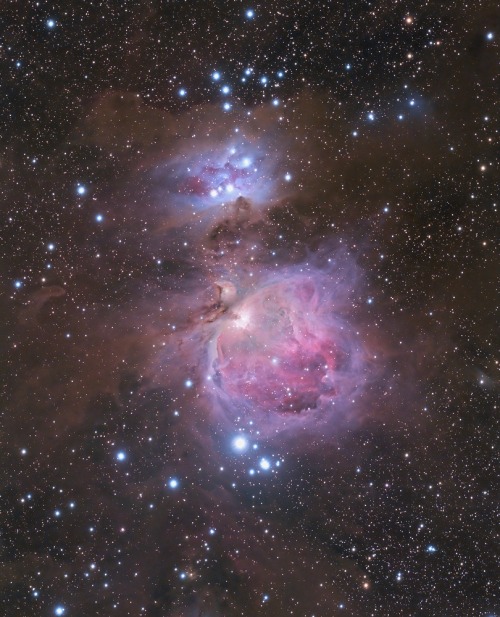Orion, The Hunter

Orion, The Hunter
More Posts from Chbnb and Others

The Fish Head Nebula, NGC 896 // Frank Dibbell

Strawberry Summer Moon

Just wow

A picture of the solar eclipse from the ISS

Heart of the Scorpion

Carina Nebula Close Up. From NASA APOD.

2025 January 27
Pleiades over Half Dome Image Credit & Copyright: Dheera Venkatraman
Explanation: Stars come in bunches. The most famous bunch of stars on the sky is the Pleiades, a bright cluster that can be easily seen with the unaided eye. The Pleiades lies only about 450 light years away, formed about 100 million years ago, and will likely last about another 250 million years. Our Sun was likely born in a star cluster, but now, being about 4.5 billion years old, its stellar birth companions have long since dispersed. The Pleiades star cluster is pictured over Half Dome, a famous rock structure in Yosemite National Park in California, USA. The featured image is a composite of 28 foreground exposures and 174 images of the stellar background, all taken from the same location and by the same camera on the same night in October 2019. After calculating the timing of a future juxtaposition of the Pleiades and Half Dome, the astrophotographer was unexpectedly rewarded by an electrical blackout, making the background sky unusually dark.
∞ Source: apod.nasa.gov/apod/ap250127.html

The Orion Nebula (M42), M43 and the Running Man Nebula.
Credit: Chad Quandt

Focus on a small portion of the Milky Way, above Canadian forest, August 2019, showing North American nebula and part the Cygnus constellation. Taken with Nikon D750, 50mm, ISO1600, 10s. I did not have a tripod, it was tricky to keep the camera still.

caress of light by Maria Franca Perra
-
 cernunnos1990 liked this · 2 years ago
cernunnos1990 liked this · 2 years ago -
 strangeandunusually reblogged this · 2 years ago
strangeandunusually reblogged this · 2 years ago -
 electric-specter liked this · 2 years ago
electric-specter liked this · 2 years ago -
 myownprivatcidaho reblogged this · 2 years ago
myownprivatcidaho reblogged this · 2 years ago -
 hiverlord liked this · 2 years ago
hiverlord liked this · 2 years ago -
 r3ndl3 reblogged this · 2 years ago
r3ndl3 reblogged this · 2 years ago -
 the-gotheltic-rowan reblogged this · 2 years ago
the-gotheltic-rowan reblogged this · 2 years ago -
 default-name-and-or-title liked this · 2 years ago
default-name-and-or-title liked this · 2 years ago -
 k-llewellin-novelist reblogged this · 2 years ago
k-llewellin-novelist reblogged this · 2 years ago -
 lodille liked this · 2 years ago
lodille liked this · 2 years ago -
 reganamicslamborghini liked this · 3 years ago
reganamicslamborghini liked this · 3 years ago -
 euphoniouspandemonium liked this · 3 years ago
euphoniouspandemonium liked this · 3 years ago -
 aarablogsthings liked this · 3 years ago
aarablogsthings liked this · 3 years ago -
 crimsonebony reblogged this · 3 years ago
crimsonebony reblogged this · 3 years ago -
 anachronistic-falsehood liked this · 3 years ago
anachronistic-falsehood liked this · 3 years ago -
 tubmax reblogged this · 3 years ago
tubmax reblogged this · 3 years ago -
 casinoroyale reblogged this · 3 years ago
casinoroyale reblogged this · 3 years ago -
 art-e-miz liked this · 3 years ago
art-e-miz liked this · 3 years ago -
 lurkandconsume liked this · 3 years ago
lurkandconsume liked this · 3 years ago -
 mis-erry liked this · 3 years ago
mis-erry liked this · 3 years ago -
 randomsofmine reblogged this · 3 years ago
randomsofmine reblogged this · 3 years ago -
 spell-god-backwards reblogged this · 3 years ago
spell-god-backwards reblogged this · 3 years ago -
 merka-420 reblogged this · 3 years ago
merka-420 reblogged this · 3 years ago -
 merka-420 liked this · 3 years ago
merka-420 liked this · 3 years ago -
 mwaml liked this · 3 years ago
mwaml liked this · 3 years ago -
 newplanetoddities reblogged this · 3 years ago
newplanetoddities reblogged this · 3 years ago -
 jesuislysandra reblogged this · 3 years ago
jesuislysandra reblogged this · 3 years ago -
 assfuckallison liked this · 3 years ago
assfuckallison liked this · 3 years ago -
 scootis-the-scoot reblogged this · 3 years ago
scootis-the-scoot reblogged this · 3 years ago -
 scootis-the-scoot liked this · 3 years ago
scootis-the-scoot liked this · 3 years ago -
 sniptra reblogged this · 3 years ago
sniptra reblogged this · 3 years ago -
 jinglejangle101 liked this · 3 years ago
jinglejangle101 liked this · 3 years ago -
 nlockett reblogged this · 3 years ago
nlockett reblogged this · 3 years ago -
 nlockett liked this · 3 years ago
nlockett liked this · 3 years ago -
 anxitea-shop reblogged this · 3 years ago
anxitea-shop reblogged this · 3 years ago -
 anxitea-shop liked this · 3 years ago
anxitea-shop liked this · 3 years ago -
 lcstkey reblogged this · 3 years ago
lcstkey reblogged this · 3 years ago -
 joseb-tito liked this · 3 years ago
joseb-tito liked this · 3 years ago -
 strangeandunusually reblogged this · 3 years ago
strangeandunusually reblogged this · 3 years ago -
 gashoukougunmoved reblogged this · 3 years ago
gashoukougunmoved reblogged this · 3 years ago
